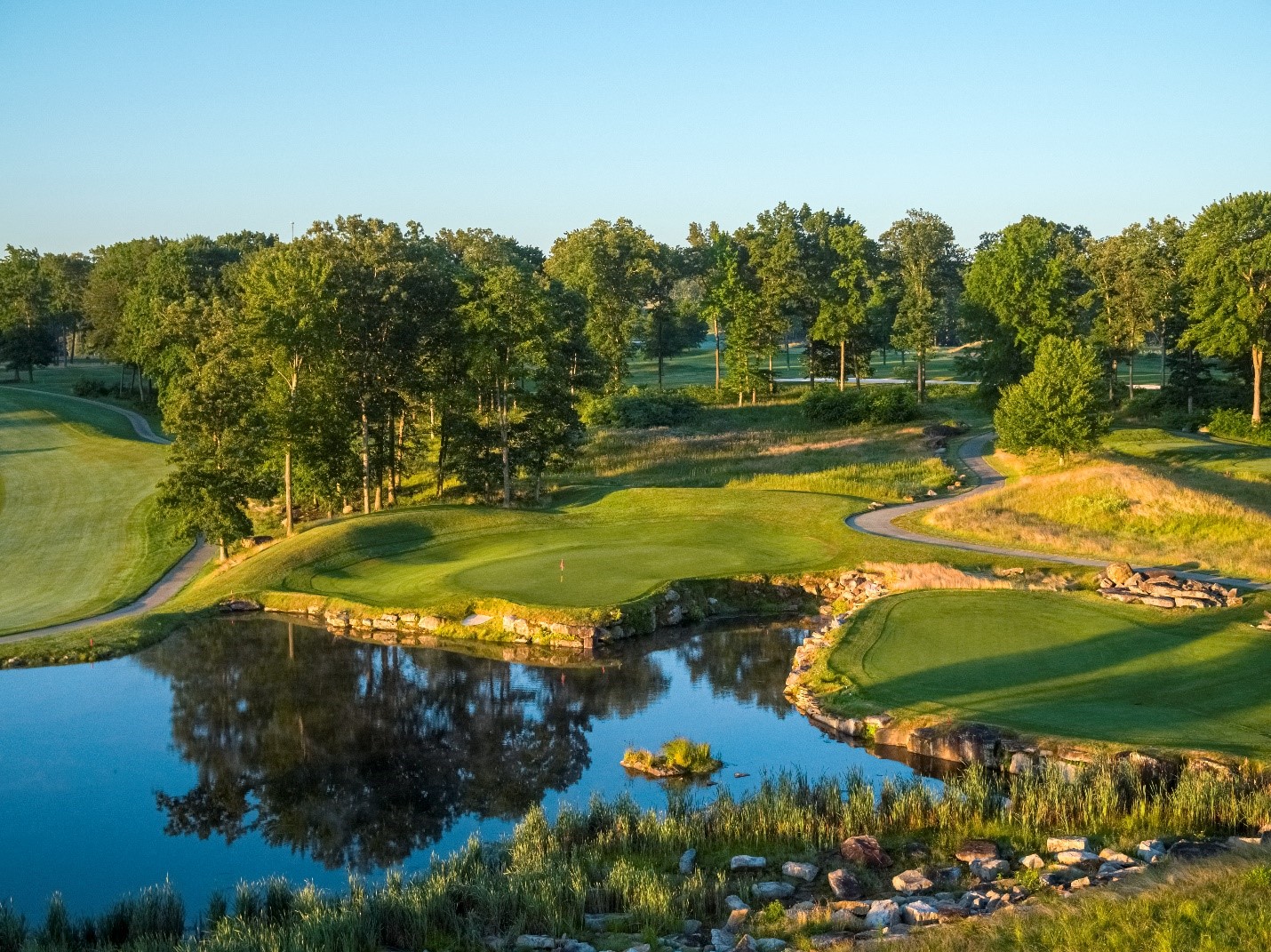By Mike Bailey
A large scoreboard looms off to the left of the green and fairway on the 18th on the Mystic Rock Course at Nemacolin, Pennsylvania’s premier luxury golf resort destination. It serves as a reminder that for a few years some of the best players in the world made their way down that fairway during the 84 Lumber Classic, a PGA Tour event that was played there from 2003 to 2006.

That scoreboard also symbolizes that Mystic Rock, the first Pete Dye golf course to open at Nemacolin in 1995, is at its core, a tournament venue. While the 7,526-yard layout no longer stages a PGA Tour event, it continues to play host to high-level tournaments, including prestigious college and pro events. It’s a course that will test every part of your game, especially your accuracy off the tee. But it also will reward excellent play, with plenty of scoring opportunities.

Looking back on the 84 Lumber Classic (84 Lumber was founded by Nemacolin’s late owner Joseph A. Hardy III), you can tell that this Pete Dye-designed Mystic Rock was a formidable challenge. In the tournament’s last two years, the winning score was just 14-under par by Jason Gore and 2003 Open Champion Ben Curtis, respectively.
Laid out among rock outcroppings on naturally rolling terrain of lakes, streams, and fescue, Mystic Rock has great flow to it, with a couple of crescendos and a fantastic finishing stretch. It’s right in front of you, for the most part. And while the length jumps out at you, it’s nothing for today’s scratch and plus handicaps, especially when conditions are firm. For the rest of us, there are four other sets of tees, ranging from 4,848 yards to 6,831 yards, so everyone can compete on it.
Dye, of course, was known for his demanding designs, but he certainly gives golfers a handful of breaks at Mystic Rock. The 409-yard first hole, though, no pushover, eases you in with a wide fairway. Hit that fairway on this dogleg right, and you will have just a wedge into a receptive and relatively flat green.
By the second hole, it already starts to get tougher.
“It’s definitely more challenging from the back tees,” says Director of Golf Operations Chris Anderson of the 473-yard, par-4 second. “There’s a lengthy forced carry over a rock ravine or you have to hit into a narrow spot on the left side of the fairway. And it is a tough second shot with a newer green and the bunkers on the left.”
Once you get to the green, it’s not that difficult, because in general, the greens on Mystic Rock, as opposed to the newer course at Nemacolin, Shepherd’s Rock, are less severe. Some of them, however, are multi-tiered, like the one on the next hole, the 231-yard par-3 third. While that seems like a long way — and it is for most players — it is 178 yards for resort guests, which still poses a challenge, of course.
Speaking of length, the yardages on a couple of the par 5s at Mystic Rock certainly stand out. The fifth is 598 yards from the back tees. And the 11th is 634 yards if you play it from the back, bottom tee (which is not used that often). The dogleg right 11th is a hole that you need to play a few times to get a feel for it. The tee shot is somewhat blind, and there are two large fairway bunkers out to right followed by a lake that runs along the right side after that all the way to the green.
But despite the length of those two holes, the par 5s are definitely scoring opportunities. College players and professionals routinely hit these holes in two shots.
At this year’s Falling Rock Classic at Nemacolin, a Tri-State PGA Section event, back-to-back champion Mike Van Sickle (son of award-winning golf writer Gary Van Sickle) rallied for the win by eagling all four par-5s on Mystic Rock. Anderson believes it might be the first time that feat has been accomplished ever in a sanctioned event in the Pittsburgh area (which would include majors at Oakmont Country Club).
Another point of interest regarding the par 5s is that the fifth has alternate greens — one on the left next to a pond and bunker, and one perched up on the right. They change them on the third and fifth day each week. The right green was not used during the 84 Lumber Classic.
The key to surviving the front nine, perhaps, is getting through the 476-yard par-4 ninth, the no. 1 handicap hole. It is a narrow fairway with a blind second shot. You have to be accurate and long.
The other hole with two greens is the par-3 12th, which plays entirely over water. The two greens used to be one wide green on the 12th, but after the first year of the PGA Tour event, they were separated to make the targets more difficult. The majority of the pin locations are available on the left green, Anderson says. And the right green has rocks, water, and a pot bunker in front of the putting surface. Because it is all carry, both tournament contestants and resort guests can rack up some high numbers on 12 if they wind up re-teeing or dropping on a more forward tee after finding the water.

Anderson’s favorite hole, and perhaps one of the last great chances for birdie, is the 13th. This dogleg right with water on the right side of the approach, is under 400 yards from the tips and features beautiful bunkering in the fairways that really frames the hole.
Once you get to 14 and 15, two par 4s that play over 460 yards, you need to be playing your best. The 16th is a par 5 that is just 525 yards from the back tees. It is gettable in two, of course, but the better birdie chance for most players is to try to play to a short wedge third shot, Anderson says.
The par-3 17th might be the 16th handicap hole, but when the wind is blowing, it’s anything but easy. With water down the entire left side, a green that slopes to the left, and a bunker right, this 204-yard hole can be particularly intimidating, especially from the tee on the left, which brings the water more into play.

Finally, we’re back to the 18th, the no. 2-handicap hole on the course. The modifications included a series of bunkers down the right side of the fairway and bunkers that guard the green. If you don’t know the hole, you are tempted to hug the right side of the fairway off the tee to set up a shorter approach on this dogleg right. But the fairway slopes right, directing balls on that side into those fairway bunkers, which can set up a difficult approach. The best bet is to aim left toward the scoreboard off the tee.
So, what’s the key to tournament success at Mystic Rock?
“It’s not only finding the fairways, but controlling where you hit it in the fairway,” Anderson says. “Obviously, you don’t have to take the driver out on every hole. If you are spraying the driver, you’re not scoring. There’s too much trouble on the edges.”
By trouble, Anderson means the rough, fescue, fairway bunkers, and of course, penalty areas.
How does Mystic stack up against the rest of the championship courses in the western part of the state? It might not have the history, of course, of Oakmont, but it’s right there,” says Anderson.
“I think we hold up pretty well,” Anderson says. “It’s quiet. You’re in the trees, the mountains, the rocks. There’s a little bit of elevation change, and it’s pretty serene.”
Not a bad spot at all, even if you’re not in contention.
https://www.nemacolin.com/golf/







